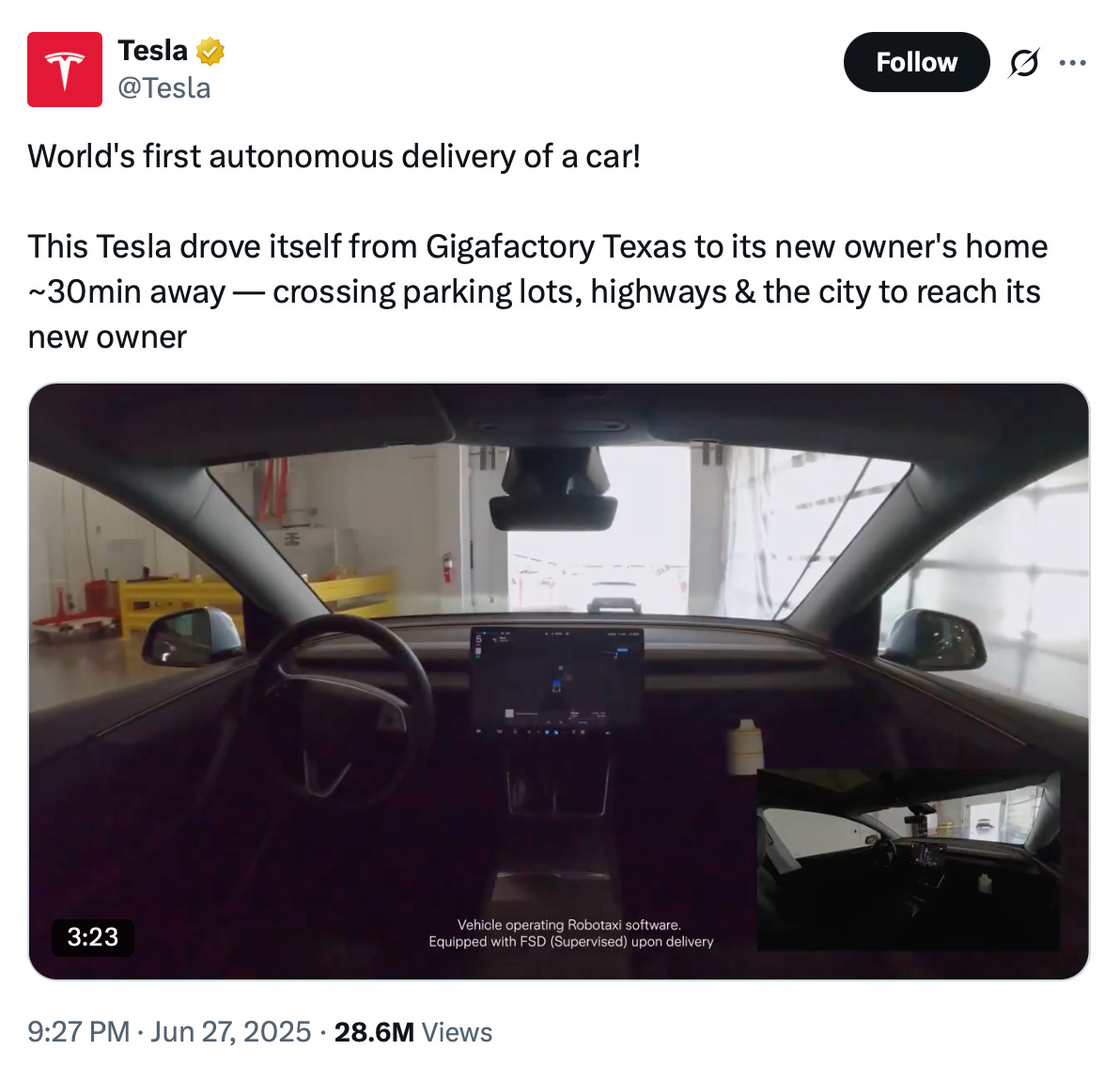What I Read This Week…
$3T+ in federal debt is set to mature soon, China’s “AI Tigers” are gaining traction by open-sourcing top models with government support, and seven people are now using Neuralink's Telepathy device
Watch All-In E233
Read our Deep Dive: A Primer on the Magnificent 7 (Part 4 - Apple)
Read our Deep Dive: A Primer on Cryptocurrencies
Come join the Besties and Me at the All-In Summit in September
Caught My Eye…
Between July and September, the U.S. Treasury will refinance over $3 trillion in maturing federal debt, part of a broader $11 trillion wave coming due over the next 12 months. This rollover is the result of years of short-term borrowing at low rates, much of which now matures just as interest rates remain elevated. Refinancing this debt at today’s yields, which are higher than those locked in during 2020–2021, could cost hundreds of billions in additional annual interest. President Trump has publicly pressed the Federal Reserve to cut interest rates by as much as 2–2.5% to ease this burden, arguing that rate reductions would save the government tens of billions, given how much short-term debt will be refinanced and inflation now trending below 2.5%. His administration has also explored maturity extension, which would involve shifting new issuance toward longer-dated bonds to lock in current rates for a longer period and reduce the volume of debt that must be rolled over each year. Beyond rate cuts, a combination of improved economic growth, low inflation, and fiscal reforms would help reduce pressure on borrowing costs. Since March, the 10-year Treasury yield has fallen from 4.6% to around 4.2%, driven by declining inflation data, clearer signals from the Federal Reserve about future rate cuts, and increased demand for Treasuries.
China’s “AI Tigers” like DeepSeek, Zhipu AI, and Moonshot are expanding globally by open-sourcing their most advanced language models and offering them to foreign governments and enterprises at no cost. These Chinese startups are backed by a blend of government funding, favorable regulation, and state-aligned cloud infrastructure, with support from tech giants like Alibaba and Huawei. Instead of relying mostly on private market funding, the Chinese system combines top-down industrial policy with aggressive state investment to accelerate domestic AI development and export. This support allows the startups to open-source their top language models and provide them to governments and enterprises that can run them locally, with full administrator access and no subscription fees. So far, this model has gained traction in countries in Southeast Asia, the Middle East, and Africa that want control over their AI infrastructure without relying on U.S. cloud platforms or incurring ongoing costs. In contrast, U.S. companies like OpenAI, Anthropic, and Google are funded by private capital and monetized via SaaS models, keeping their most advanced models behind paywalls, usage-based APIs, and strict licensing terms. OpenAI has publicly raised concerns about companies like Zhipu AI, citing national security risks tied to the Chinese government and warning that widespread use of Chinese open-source models could seed global AI ecosystems with Chinese code and standards. If Chinese AI companies gain traction globally, this would reduce America’s ability to influence the trajectory of AI and sustain economic primacy in the decades ahead.
Neuralink revealed that seven participants with paralysis are now using its brain-computer interface, Telepathy, to control devices through thought alone. The wireless implant, embedded in the motor cortex, records neural activity through over 1,000 microscopic electrodes and converts intended movements into digital actions. In one demonstration, a user broke the world record for brain-controlled cursor speed on his first day post-implantation. Others now use the system to send emails, play video games, and control robotic arms, with some logging more than 100 hours of weekly use. Critically, the implant has remained stable and effective without serious complications, supporting Neuralink’s goal of restoring digital autonomy to those with spinal cord injuries or ALS. This milestone demonstrates that the implant can translate raw motor intent into real-time control with unprecedented speed and precision. Neuralink is now preparing for the next phase: expanding channel count, decoding speech directly from the brain, and starting trials for restoring sight through its second product, Blindsight. If the company succeeds, it will mark an inflection point not only for medical rehabilitation but for the broader field of human-computer integration.
Other Reading
The Stock-Market Rally Could Be Moving Beyond Big Tech (Wall Street Journal)
U.S. Durable Goods Orders Increase in May on Aircraft (Reuters)
Meta Seeks $29B From Private Credit Giants to Fund AI Data Centers (Financial Times)
Nvidia Insiders Cash Out $1B Worth of Shares (Financial Times)
Why AI Video Avatars are Serving Some of the World’s Biggest Companies (Fortune)
OpenAI Doubles Down on Consulting Services (The Information)
Baidu's Plans to Release Open-Source Language Model ‘Ernie’ Tomorrow (CNBC)
One American’s Two-Year Quest to Move His Business Out of China (Wall Street Journal)
China’s 20 Astronauts Complete Second Spacewalk on Tiangong Space Station (SpaceNews)
U.S. Energy Groups Spend Record Sums on Power Plants to Feed Data Centers (Financial Times)
Dinari Granted First Broker-Dealer Registration to Offer Tokenized Stocks (Reuters)
On X…









US govt has to incentivize collaboration among our top AI-initiative corporations.
While competition is inherently good, it will mean nothing if China beats the US to superintelligence
Forget Free College, How About We Fix K-12 First?
https://torrancestephensphd.substack.com/p/forget-free-college-how-about-we
China Is Digging a 10,000-Meter Hole Into the Earth—And Their True Motive Might Surprise You
https://dailygalaxy.com/2025/08/china-is-digging-a-10000-meter-hole-into-the-earth-and-their-true-motive-might-surprise-you/
India Responds To Trump Levying Additional 25% Tariff — 'Will Take All Actions Necessary'
https://www.ndtvprofit.com/amp/economy-finance/india-responds-to-trump-additional-25-tariff-will-take-all-actions-necessary-full-statement